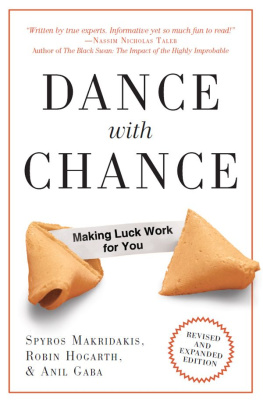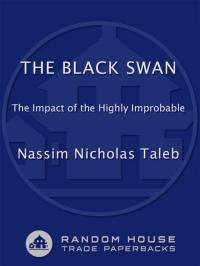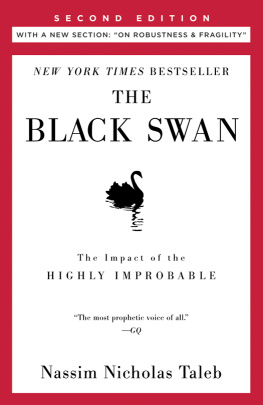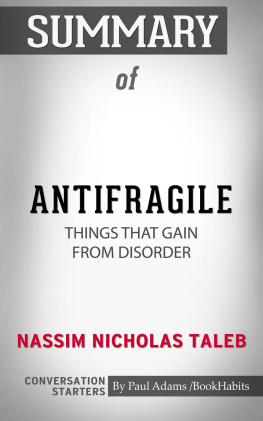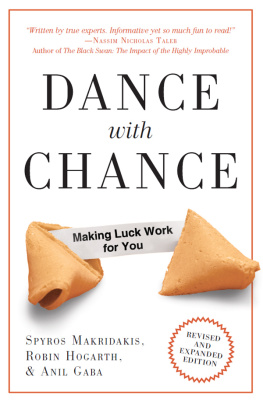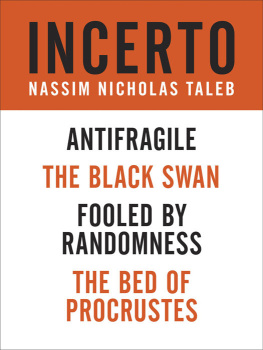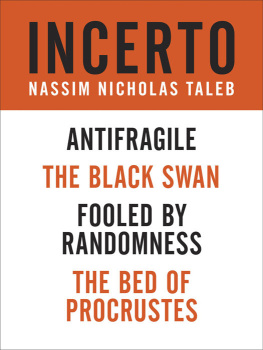Absolutely fascinating! A must read!
Robert J. Herbold Executive Vice President and Former
Chief Operating Officer, Microsoft Corporation
Provides fascinating evidence that we fail to recognize the role of chance, and as a result make strategic errors that reduce our wealth, health, career success, and happiness.
Max H. Bazerman Straus Professor of Business Administration,
Harvard Business School
Much of what appears in management literature is nothing more than a recycling of old ideas. Dance with Chance is different. In an extremely erudite but also very readable way, the authors shatter many of our myths about the way we make decisions. A must!
Manfred Kets de Vries author of Leaders, Fools and Impostors:
Essays on the Psychology of Leadership
In an honest and enjoyable book, three experts on chance show how we can gain power over the future by abandoning the illusion that we control it.
Waterstones Books Quarterly
An extremely timely bookfresh and informativeA thorough and instructive analysis of uncertainty.
City AM
A very useful and timely book.
Peter Taylor-Gooby FRSA Director of ESRC
Risk Programme, University of Kent
An important book. These guys hit the mark, providing an informed and useful perspective on wealth, health, and happiness.
Fred Collopy Professor and Chair of Information Systems,
Weatherhead School of Management, Ohio
Brilliant and engaging. Particularly relevant in the current global economic and financial crisis, it reads like a thriller and I could not put it down.
Vijai Gill CEO, Salamander Capital, UK
A motivational jackpot! Turns conventional wisdom on its head by offering the reader a profoundly important and counterintuitive idea: the best way to be in control is to release control. Full of striking statistics, yet remains fast-moving and eminently readable.
Bill Treasurer Author of Right Risk: 10 Powerful Principles
for Taking Giant Leaps
Informed, well-written, and entertaining. The central message turns out to be liberating and life-affirming.
David Orrell Author of The Future of Everything: The
Science of Prediction
Provides fresh ways of dealing with the basic problem of what is knowable and what is not, and our understanding of the difference between the two. It has the strength of making complex and subtle discussions very accessible to the reader.
Bernard Drury President and CEO, Drury Capital Inc.
Captivating. A must read for powerful decision making in an uncertain world.
Daniel Labrecque President & CEO, N M Rothschild & Sons, Canada
DANCE WITH CHANCE
ABOUT THE AUTHORS
Spyros Makridakis
is Distinguished Research Professor at INSEAD, Abu Dhabi Centre and a former Greek Olympian.
Robin M. Hogarth
is ICREA Research Professor at Universitat Pompeu Fabra, Spain. He was formerly a professor at the University of Chicagos Booth School of Business.
Anil Gaba
is the ORPAR Chaired Professor of Risk Management and Academic Director of the Centre for Decision Making and Risk Analysis at INSEAD, France and Singapore, the worlds second largest business school.
DANCE WITH CHANCE
Making luck work for you
SPYROS MAKRIDAKIS,
ROBIN HOGARTH, ANIL GABA

A Oneworld Book
First published by Oneworld Publications 2009
Reprinted 2009
Revised paperback edition published by Oneworld Publications 2010
This ebook edition published by Oneworld Publications 2011
Copyright Makridakis, Hogarth, Gaba 2009, 2010
The right of Makridakis, Hogarth, and Gaba to be identified as the Authors of this work has been asserted by them in accordance with the Copyright, Designs and Patents Act 1988
All rights reserved
Copyright under Berne Convention
A CIP record for this title is available from the British Library
ISBN 9781780740140
Typeset by Jayvee, Trivandrum, India
Cover design by Keenan Design
Oneworld Publications
185 Banbury Road
Oxford OX27AR
England
Learn more about Oneworld. Join our mailing list to find out about our latest titles and special offers at:
www.oneworld-publications.com
CONTENTSACKNOWLEDGMENTSS ince starting to work on this book, we have been the grateful recipients of different forms of help from many individuals and organizations. First, many colleagues and friends read various drafts of the book, challenged us to clarify our thinking, examples, and exposition, and further provided many constructive suggestions. These included Fred Collopy, Gerd Gigerenzer, Reid Hastie, Bob Herbold, Tassos Karagiannis, Manfred Kets de Vries, Toms Lejarraga, and Emre Soyer, as well as Grace Hung, Chris Lobello, and other readers at CLSA. In addition, the text reflects comments made by Irina Cojuharenco, Spyros Efstathopoulos, Natalia Karelaia, Gueorgui Kolev, George Koumbas, Litsa Panagiotopoulou, Carmen Pi-Sunyer, and Eric Thomson. However, our greatest debt goes to Elin Williams who not only vastly improved our attempts to write but also corrected our way of dealing with many issues and always with good humor.
This book was written in four different places: Athens, Barcelona, Fontainebleau, and Singapore. In particular, we spent three intensive weeks together engaged in the project at INSEAD in Singapore and thank that institution for its support, especially the Centre for Decision Making and Risk Analysis (CDMRA) which also provided financial resources throughout the project. Robin Hogarth thanks the Spanish Ministerio de Ciencia e Innovacin for its financial aid.
Finally, we thank Mike Harpley and the team at Oneworld for committing itself so wholeheartedly to our project.
PREFACEBefore we begin...
D ance with Chance was created from a meeting of minds. The minds belong to three professors with a shared interest in the human need to predict and influence the future.
It all began way back in the 1970s, when one of the professors, a statistician by training, had an unpleasant surprise. Hed noticed that business people were failing to use the latest statistical techniques in their forecasting and so embarked on some research to persuade them to become more mathematically sophisticated. But to the professors intellectual horror (not to mention a little shame) the research showed that the practitioners simple methods were better at predicting than his own clever ones. He reluctantly began to wonder whether people should put more faith in human intuition than mathematics when predicting the future.
The statistician happened to mention this dilemma to one of his colleagues, a cognitive psychologist. Sorry, said the second professor, empirical findings in my field show that human judgment is even less accurate at making predictions than statistical models. And for a long time, they both carried on thinking about this, which is what professors do best. Years later, the two men returned to the famous business school where theyd first met and got talking to a third professor. He turned out to be a decision scientist, whose research was all about reconciling theory with practice, the irrational with the rational, statistical models with gut feeling.
And so Dance with Chance was ignited by this intellectual spark, with the goal of helping people make better decisions in situations where accurate forecasting is just not possible. The key insight, it turns out, is to accept uncertainty and recognize exactly what can and cannot be predicted the limits to predictability. Only then can we realistically manage the uncertainty we confront in our daily lives and avoid falling victim to the vagaries of chance.
Next page
